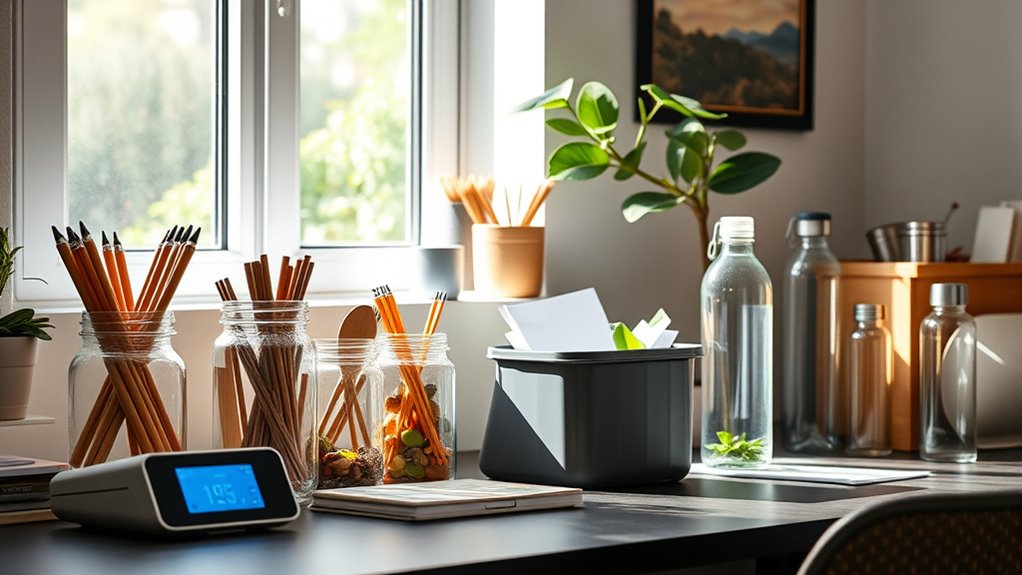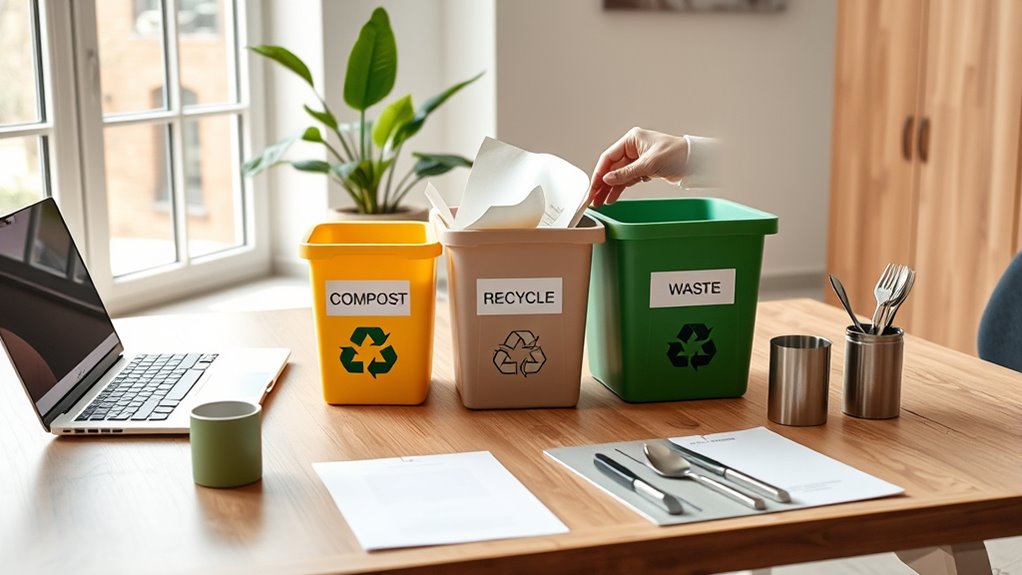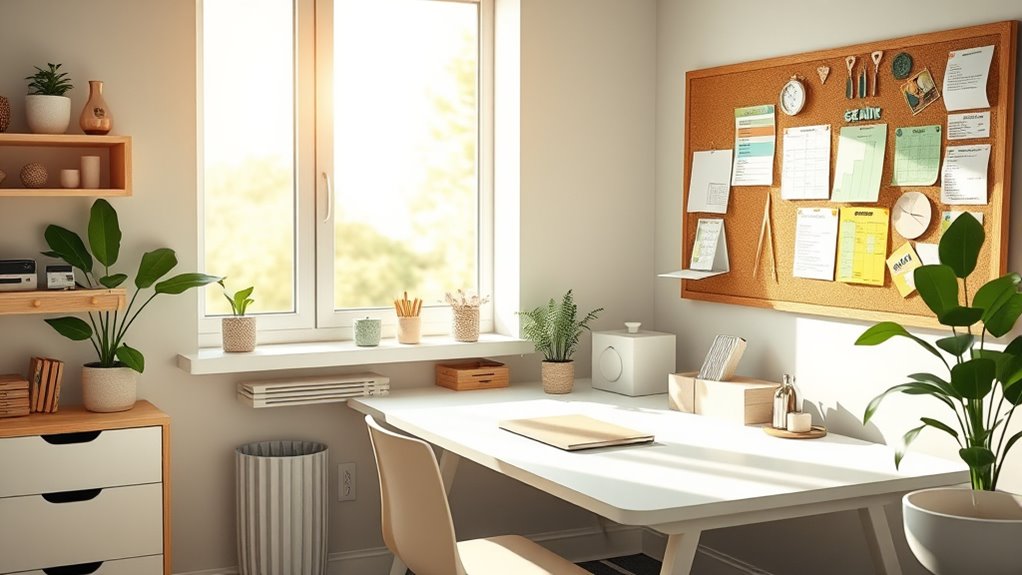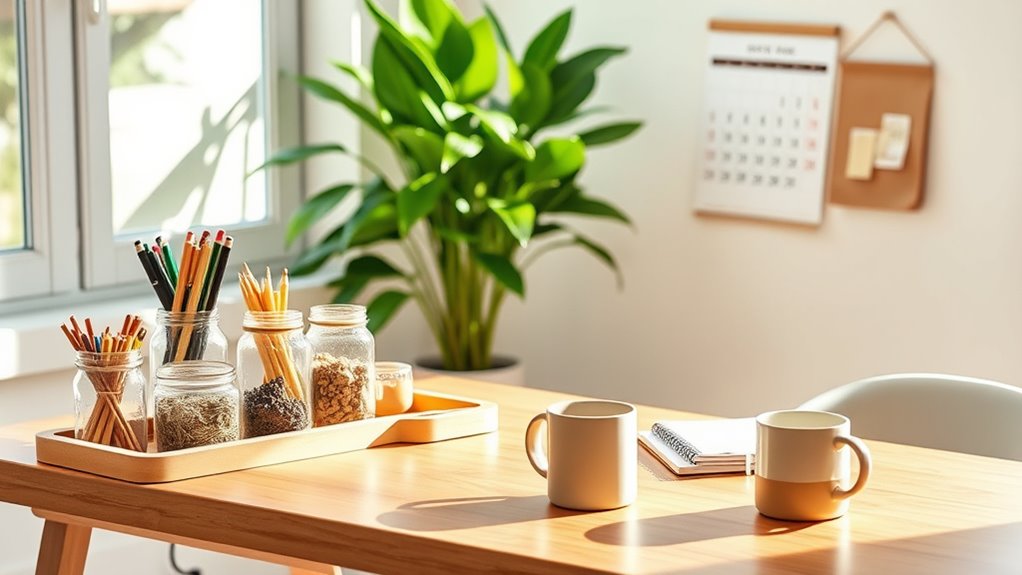To create a zero-waste home office, start by evaluating your current waste habits through a waste audit to identify major sources of waste. Then, streamline disposal by using labeled bins and proper sorting practices. Shift to digital documents and reusable supplies like pens and water bottles to cut down on single-use items. Next, adopt practical waste reduction measures such as eco-friendly packaging and composting. Continuing this approach helps you achieve your goals—discover more tips to strengthen your efforts.
Key Takeaways
- Conduct a waste audit to identify main sources of office waste and opportunities for reduction.
- Implement clearly labeled recycling, compost, and trash bins, and educate household members on proper waste sorting.
- Transition to digital documents, cloud storage, and reusable office supplies to minimize paper and plastic waste.
- Use reusable items like cups, utensils, and stationery, and choose eco-friendly packaging for deliveries.
- Track waste metrics, celebrate milestones, and share progress to motivate ongoing waste reduction efforts.
Assess Your Current Waste Habits

To effectively reduce waste in your home office, you need to start by evaluating your current habits. Begin with a waste audit, tracking your office waste over a week to identify major sources. Review your disposal practices to see if recyclable and compostable materials are being sorted properly and if any waste is unnecessary. Analyze your paper usage—note how many sheets you print or discard—and consider digital alternatives to cut down on paper waste. Check your habits with single-use items like disposable cups, pens, or packaging, and look for opportunities to switch to reusables. Additionally, adopting vertical storage solutions can help reduce clutter and make waste management more efficient. Involving necessary cookies in your audit process can help track how you interact with waste management practices on related digital tools. Implementing zero-waste principles can further guide your efforts toward sustainability. Finally, measure how often and how much waste you dispose of to understand your waste footprint. Incorporating sustainable waste management practices can significantly improve your efforts. Being aware of local recycling regulations can help ensure you’re disposing of materials correctly. This assessment helps you set realistic goals for creating a more sustainable office.
Streamline Waste Sorting and Disposal

Organizing your waste sorting system is essential for maintaining a sustainable home office. Clear, labeled waste bins for recycling, composting, and trash make it easier to separate materials correctly. Place these bins in accessible spots, and move trash cans away from desks to foster mindful waste disposal and reduce habitually tossing recyclables. Use visual cues and signage near waste stations to reinforce proper waste sorting practices, improving recycling accuracy. Regularly monitor and empty bins to prevent contamination and ensure proper processing for recycling or composting. Educate everyone in your household about what can be composted, recycled, or trashed to boost waste diversion and waste reduction efforts. Incorporating sound science principles into your waste management practices can further enhance your sustainability efforts. Additionally, understanding the types of waste generated can help optimize your sorting system for better efficiency. Implementing a waste audit can provide insights into your current waste habits and identify areas for improvement. This organized approach simplifies waste management and keeps your home office aligned with zero-waste principles.
Transition to Digital and Reusable Supplies

Switching to digital and reusable supplies can markedly reduce your home office’s environmental impact. By adopting digital documents and cloud-based storage, you can eliminate up to 80% of paper waste, making your workspace more sustainable. Reusable supplies like pens, pencils, and markers cut down on single-use items that often end up in landfills within months. Using rechargeable batteries for electronic devices prevents thousands of disposable batteries from being discarded each year, supporting environmentally friendly practices. Additionally, replacing disposable office supplies with refillable or sustainably sourced options decreases plastic and packaging waste considerably. Incorporating sustainable materials into your office setup can further enhance your eco-friendly efforts. Implementing recycling programs in your workspace encourages ongoing waste reduction and environmental responsibility. Understanding ethical hacking principles can also inspire innovative solutions for securing your digital workspace and protecting sensitive information. This shift not only minimizes office waste but also promotes a more sustainable approach to your daily work routine. Embracing digital and reusable supplies is a smart step toward a zero-waste and environmentally conscious home office.
Implement Practical Waste Reduction Measures

Building on your efforts to adopt digital and reusable supplies, implementing practical waste reduction measures takes your home office sustainability to the next level. Focus on minimizing waste from everyday activities by choosing compostable or recyclable packaging for mail and deliveries. Set up centralized recycling and compost bins in accessible areas to encourage proper waste segregation. Switch to reusable office supplies like pens, notebooks, and folders to eliminate single-use waste. Incorporate reusable cups, water bottles, and utensils to reduce disposable food and beverage waste. Additionally, manage food waste effectively by composting organic scraps instead of discarding them. Incorporate tea accessories and merchandise to further enhance your efforts in creating a zero-waste home office that minimizes waste and promotes responsible waste management practices.
Track Progress and Celebrate Achievements

Tracking your progress is essential to maintaining momentum and identifying areas for improvement in your zero-waste home office. By regularly recording waste management metrics, like diversion rates and the amount of waste sent to landfills, you can monitor progress effectively. Celebrate milestones such as halving paper use or achieving a month of zero food waste through team recognition or personal rewards. Use data from waste audits to pinpoint where you can reduce waste further and set new goals. Sharing successes and environmental impacts with household members keeps everyone motivated. Recognizing consistent efforts—like maintaining composting routines or reducing single-use plastics—reinforces positive habits. Incorporating global intelligence insights into your waste reduction strategies can help you stay ahead of emerging trends and innovative solutions. Staying informed about preppy dog names and other breed-specific suggestions can inspire creative ways to personalize your workspace and keep morale high. Additionally, understanding eye patch benefits and their proper use can contribute to a healthier work environment by reducing the need for unnecessary skincare products. Regularly researching Gold IRA investment options can open up new avenues for financial security and diversification. Keeping track of production quantity variance and other financial metrics can also provide valuable insights into your overall resource management. Celebrating these achievements not only boosts morale but also sustains your commitment to reducing waste and minimizing environmental impacts.
Frequently Asked Questions
What Are the 5 Steps to Zero Waste?
To achieve zero waste, start by conducting a waste audit to identify your main waste sources. Then, switch to reusable items like mugs and containers to cut disposable waste. Next, sort and compost organic waste properly. After that, optimize digital workflows to reduce paper use. Finally, track your progress and celebrate milestones to stay motivated and continuously improve your sustainability efforts.
What Are the 5 Concepts of Zero Waste Management?
Think of zero waste management as a treasure map guiding you to sustainability. The five core concepts—refuse, reduce, reuse, recycle, and rot—shape your approach. You refuse unnecessary packaging, reduce consumption, reuse items creatively, recycle materials properly, and rot organic waste into compost. By following these steps, you close the loop, transforming waste into valuable resources and making your home office eco-friendly and waste-free.
How to Make a Zero Waste Pattern?
To make a zero-waste pattern, start by planning your design carefully to maximize fabric use. Use geometric shapes and tessellations that fit together without leftovers. Employ pattern drafting software or sketch manually, focusing on symmetrical or modular layouts. Cut your fabric precisely to minimize scraps, and consider upcycling or patchwork techniques for any leftover pieces. This approach helps you create sustainable, waste-free clothing patterns efficiently.
How to Create a Zero Waste Home?
To create a zero-waste home, start by conducting a waste audit to identify key waste streams. Switch to digital tools and double-sided printing to cut paper use. Use reusable items like bottles and containers to avoid single-use plastics. Set up recycling and compost stations for proper disposal, and educate yourself on sustainable practices. These steps help you reduce waste and live more sustainably in your home.
What Are the Five Rs of the Zero Waste Movement?
Oh, so you want to save the planet one tiny step at a time? The Five Rs of the zero waste movement are Refuse, Reduce, Reuse, Recycle, and Rot. You refuse unnecessary packaging, reduce consumption, reuse items whenever you can, recycle what’s left, and rot organic waste into compost. Follow these, and you’ll be a waste-fighting hero — or at least, a little less of a trash monster.
Conclusion
By following these five steps, you’re well on your way to a zero-waste home office. Did you know that the average office worker generates about 2 pounds of waste daily? Small changes can make a big difference—saving resources and reducing landfill impact. Keep tracking your progress, celebrate your successes, and stay committed. Every effort counts toward creating a more sustainable workspace and a healthier planet for everyone.









